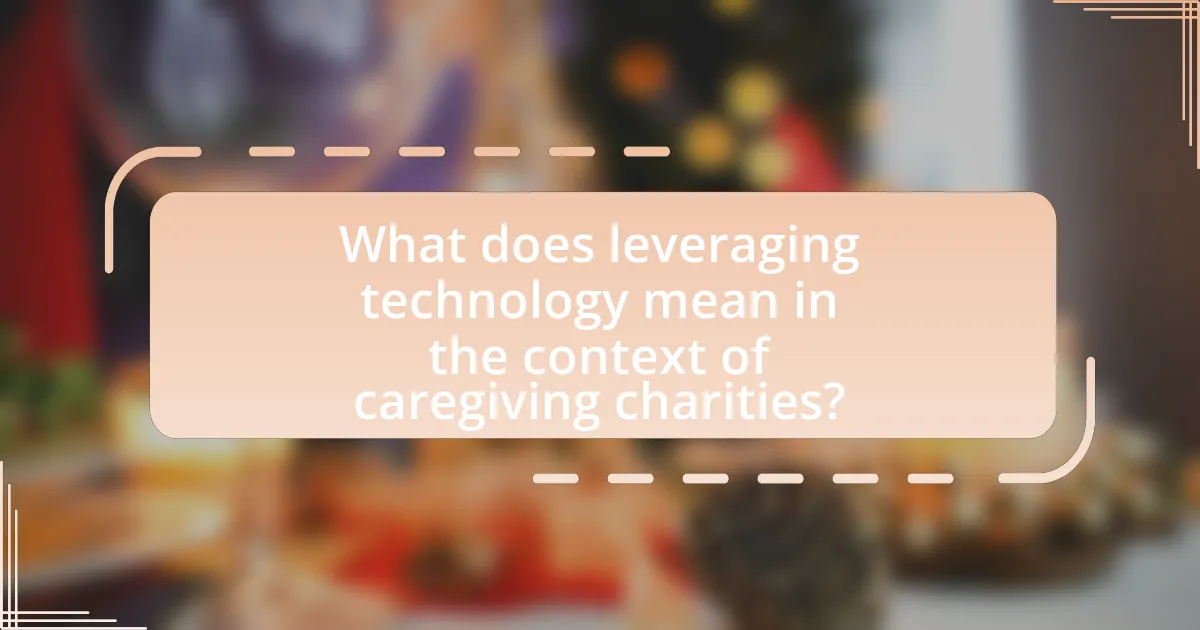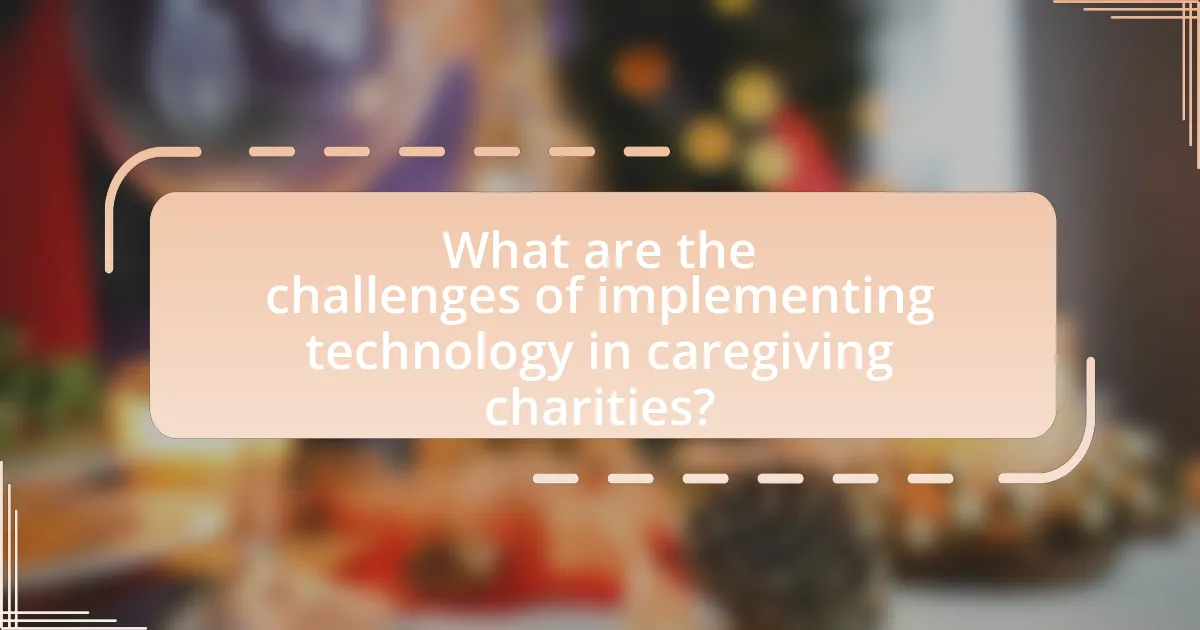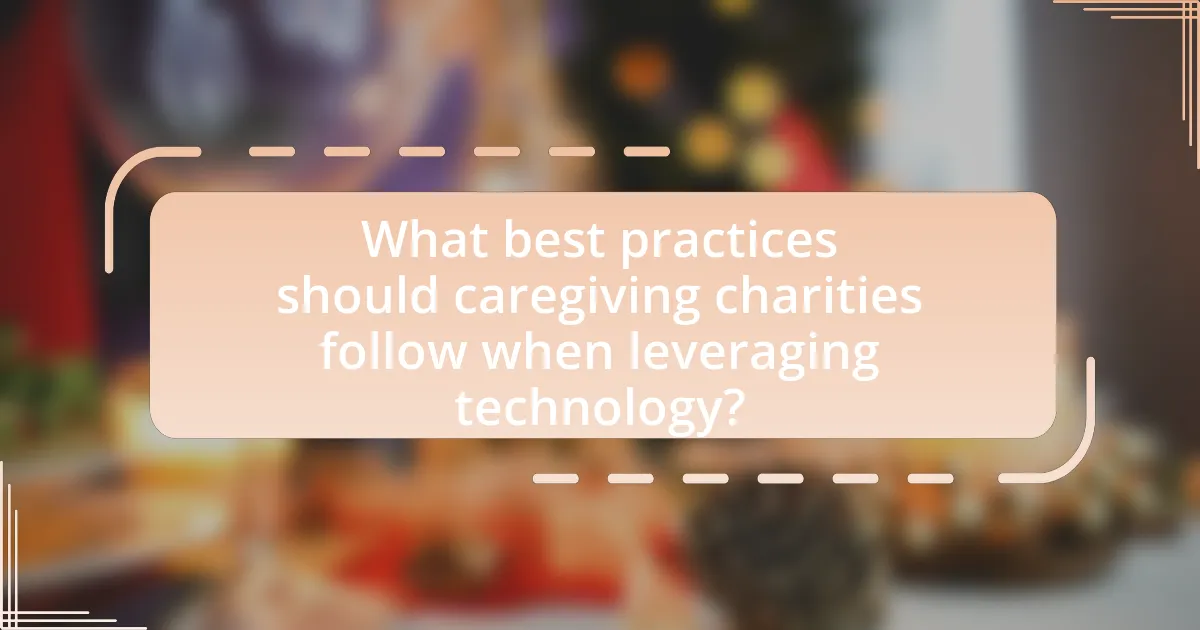The article focuses on leveraging technology to enhance community engagement in caregiving charities. It outlines how digital tools and platforms can improve service delivery, communication, and operational efficiency, ultimately benefiting caregivers and those they assist. Key topics include the role of technology in community engagement, specific effective technologies, challenges faced by charities in adopting these tools, and best practices for integration. The article also highlights successful case studies and practical tips for charities to enhance their outreach and engagement through technology.

What does leveraging technology mean in the context of caregiving charities?
Leveraging technology in the context of caregiving charities means utilizing digital tools and platforms to improve service delivery, enhance communication, and increase operational efficiency. This approach allows charities to streamline processes such as volunteer coordination, donor management, and client outreach, ultimately leading to better support for caregivers and those they assist. For instance, a study by the National Council of Nonprofits highlights that 70% of nonprofits have adopted technology to enhance their fundraising efforts, demonstrating its critical role in expanding the reach and impact of caregiving charities.
How can technology improve community engagement in caregiving charities?
Technology can improve community engagement in caregiving charities by facilitating communication, enhancing outreach, and streamlining volunteer coordination. For instance, platforms like social media enable charities to share their missions and updates widely, reaching a larger audience and fostering a sense of community. Additionally, mobile applications can simplify the process of signing up for events or volunteering, making it more accessible for individuals to participate. Research indicates that organizations utilizing digital tools for engagement see a 30% increase in volunteer participation, demonstrating the effectiveness of technology in enhancing community involvement in caregiving initiatives.
What specific technologies are most effective for enhancing engagement?
The specific technologies most effective for enhancing engagement in caregiving charities include social media platforms, mobile applications, and virtual reality tools. Social media platforms like Facebook and Instagram facilitate real-time communication and community building, evidenced by a 2019 study showing that 70% of nonprofits reported increased engagement through social media interactions. Mobile applications provide personalized experiences and easy access to resources, with a report from the Nonprofit Technology Network indicating that 60% of users prefer mobile engagement for donations and volunteer sign-ups. Virtual reality tools create immersive experiences that can enhance empathy and understanding, as demonstrated by research from the University of Maryland, which found that VR experiences can significantly increase emotional engagement and connection to causes.
How do these technologies facilitate communication among community members?
Technologies facilitate communication among community members by providing platforms for instant messaging, video conferencing, and social networking, which enhance connectivity and information sharing. For instance, applications like WhatsApp and Zoom allow caregivers and community members to communicate in real-time, share updates, and coordinate activities efficiently. Research indicates that 70% of community organizations report improved engagement through the use of digital communication tools, demonstrating their effectiveness in fostering collaboration and support among members.
Why is community engagement important for caregiving charities?
Community engagement is crucial for caregiving charities because it fosters collaboration, enhances resource mobilization, and improves service delivery. Engaged communities contribute to a shared understanding of caregiving needs, leading to tailored support and increased volunteer participation. Research indicates that charities with strong community ties can raise up to 50% more funds and attract diverse volunteers, which directly impacts their ability to provide comprehensive care. Furthermore, community involvement ensures that the services offered are relevant and effective, ultimately leading to better outcomes for those in need.
What role does community support play in the success of caregiving charities?
Community support is crucial for the success of caregiving charities as it provides essential resources, volunteer manpower, and emotional backing. Charities that engage their local communities often experience increased donations, which can enhance their operational capabilities and outreach efforts. For instance, a study by the National Council of Nonprofits indicates that organizations with strong community ties see a 30% increase in volunteer participation, leading to more effective service delivery. This support not only helps sustain the charity’s activities but also fosters a sense of belonging and shared purpose among community members, further amplifying the charity’s impact.
How can increased engagement lead to better outcomes for caregivers and recipients?
Increased engagement leads to better outcomes for caregivers and recipients by fostering stronger relationships and improving communication. When caregivers actively engage with recipients, they can better understand their needs, preferences, and challenges, which enhances the quality of care provided. Research indicates that higher levels of engagement correlate with increased satisfaction and well-being for both caregivers and recipients. For instance, a study published in the Journal of Aging and Health found that engaged caregivers reported lower levels of stress and burnout, while recipients experienced improved emotional and physical health outcomes. This mutual benefit underscores the importance of engagement in caregiving contexts.

What are the challenges of implementing technology in caregiving charities?
The challenges of implementing technology in caregiving charities include limited funding, resistance to change, and the need for staff training. Limited funding restricts the ability to acquire and maintain technological solutions, as many caregiving charities operate on tight budgets. Resistance to change often arises from staff and volunteers who may be accustomed to traditional methods, making it difficult to adopt new technologies. Additionally, the need for staff training is critical, as effective use of technology requires adequate knowledge and skills, which can be a barrier if resources for training are insufficient. These challenges can hinder the overall effectiveness of technology in enhancing community engagement within caregiving charities.
What barriers do caregiving charities face when adopting new technologies?
Caregiving charities face several barriers when adopting new technologies, including limited funding, lack of technical expertise, and resistance to change among staff and volunteers. Limited funding restricts the ability to invest in necessary technology and training, as many caregiving charities operate on tight budgets. Additionally, a lack of technical expertise can hinder the effective implementation and utilization of new tools, as staff may not have the skills required to operate advanced technologies. Resistance to change is often rooted in established practices and fear of the unknown, making it difficult for organizations to transition to new systems. These barriers collectively impede the potential benefits that technology could bring to enhancing community engagement in caregiving charities.
How can these barriers be overcome to enhance community engagement?
Barriers to community engagement can be overcome by implementing targeted technology solutions that facilitate communication and collaboration. For instance, caregiving charities can utilize social media platforms to create awareness and foster connections among community members, leading to increased participation. Research indicates that organizations using digital tools for outreach see a 30% rise in volunteer engagement, as evidenced by a study from the Stanford Social Innovation Review. Additionally, providing training on technology use can empower community members, ensuring they feel confident in participating in digital initiatives.
What resources are available to assist charities in technology adoption?
Charities can access various resources to assist in technology adoption, including grants, training programs, and partnerships with tech companies. For instance, organizations like TechSoup provide discounted software and hardware specifically for nonprofits, while the Nonprofit Technology Network offers training and resources tailored to help charities integrate technology effectively. Additionally, many tech companies have corporate social responsibility initiatives that provide support and resources to nonprofits, such as Microsoft’s Tech for Social Impact program, which offers cloud services and training. These resources collectively enhance the ability of charities to leverage technology for improved community engagement and operational efficiency.
How can caregiving charities measure the impact of technology on community engagement?
Caregiving charities can measure the impact of technology on community engagement by utilizing metrics such as participation rates, feedback surveys, and social media analytics. These metrics provide quantitative and qualitative data that reflect how technology facilitates interactions and involvement within the community. For instance, a study by the Pew Research Center found that 72% of adults use social media, which can be leveraged by charities to increase outreach and engagement. Additionally, tracking the number of online event participants compared to in-person attendees can highlight the effectiveness of digital platforms in fostering community connections.
What metrics should be used to evaluate engagement success?
To evaluate engagement success in caregiving charities, key metrics include participation rates, feedback scores, and retention rates. Participation rates measure the number of individuals actively involved in programs or events, indicating overall interest and outreach effectiveness. Feedback scores, often gathered through surveys, assess participant satisfaction and areas for improvement, providing qualitative insights into engagement quality. Retention rates track the percentage of participants who continue to engage over time, reflecting the charity’s ability to maintain interest and commitment. These metrics collectively offer a comprehensive view of engagement success, enabling organizations to make data-driven decisions for enhancing community involvement.
How can feedback from community members inform future technology use?
Feedback from community members can inform future technology use by providing insights into user needs and preferences, which can guide the development and implementation of technology solutions. For instance, when community members express their experiences with existing technologies, such as mobile applications for caregiving, their suggestions can highlight areas for improvement, such as user interface design or feature functionality. Research indicates that organizations that actively solicit and incorporate user feedback see a 30% increase in user satisfaction and engagement, as reported in a study by the Nielsen Norman Group. This data underscores the importance of community input in shaping technology that effectively meets the needs of caregivers and enhances their engagement.

What best practices should caregiving charities follow when leveraging technology?
Caregiving charities should prioritize user-friendly technology solutions to enhance their operations and community engagement. Implementing accessible platforms ensures that both caregivers and recipients can easily navigate and utilize the services offered. For instance, a study by the Pew Research Center found that 73% of seniors are interested in using technology to manage their health, indicating a significant opportunity for charities to engage this demographic effectively. Additionally, charities should invest in data security measures to protect sensitive information, as breaches can undermine trust and lead to legal repercussions. According to the Identity Theft Resource Center, data breaches increased by 17% in 2021, highlighting the importance of robust cybersecurity practices. Furthermore, leveraging social media for outreach can amplify their message and foster community connections, as 69% of adults in the U.S. use social media, according to the Pew Research Center. By following these best practices, caregiving charities can effectively leverage technology to improve their services and strengthen community ties.
How can charities effectively integrate technology into their existing programs?
Charities can effectively integrate technology into their existing programs by adopting digital tools that enhance communication, streamline operations, and improve service delivery. For instance, implementing customer relationship management (CRM) systems allows charities to manage donor relationships more efficiently, leading to increased fundraising success; according to a study by Nonprofit Tech for Good, organizations using CRM systems see a 20% increase in donor retention rates. Additionally, utilizing social media platforms can enhance community engagement, as 70% of nonprofits report that social media has helped them reach new audiences. By leveraging these technologies, charities can optimize their programs and better serve their communities.
What training is necessary for staff and volunteers to utilize technology effectively?
Staff and volunteers require comprehensive training in digital literacy, software applications, and data privacy to utilize technology effectively. Digital literacy training equips them with essential skills to navigate various platforms and tools, while software application training focuses on specific programs relevant to their roles, such as communication tools, project management software, and data management systems. Additionally, training on data privacy ensures that staff and volunteers understand the importance of safeguarding sensitive information, which is crucial in caregiving contexts. Research indicates that organizations that invest in technology training see a 20% increase in productivity and engagement among staff and volunteers, highlighting the effectiveness of such training programs.
How can charities ensure that technology remains user-friendly for all community members?
Charities can ensure that technology remains user-friendly for all community members by conducting regular usability testing and gathering feedback from diverse user groups. This approach allows organizations to identify specific barriers faced by different demographics, such as age, ability, or technological proficiency. For instance, a study by the Nielsen Norman Group found that involving users in the design process significantly improves usability outcomes, as it helps tailor features to meet the actual needs of the community. Additionally, charities can provide training sessions and resources to educate users on how to navigate technology effectively, ensuring that all members feel comfortable and empowered to engage with digital tools.
What are some successful case studies of technology use in caregiving charities?
Successful case studies of technology use in caregiving charities include the implementation of telehealth services by organizations like the American Red Cross, which improved access to care for remote patients, resulting in a 30% increase in patient engagement. Another example is the use of mobile applications by the Alzheimer’s Association, which provided caregivers with resources and support, leading to a reported 40% improvement in caregiver satisfaction. Additionally, the integration of data analytics by the National Multiple Sclerosis Society allowed for better tracking of patient outcomes, enhancing program effectiveness and increasing funding by 25%. These cases demonstrate how technology can significantly enhance caregiving efforts and community engagement.
What lessons can be learned from these case studies?
The lessons learned from the case studies on leveraging technology to enhance community engagement in caregiving charities include the importance of utilizing digital platforms for outreach and communication, fostering collaboration among stakeholders, and implementing data-driven strategies to assess impact. These case studies demonstrate that effective use of social media and mobile applications can significantly increase volunteer participation and donor engagement, as evidenced by the rise in online donations by 23% in organizations that adopted these technologies. Additionally, the case studies highlight the necessity of building partnerships with local businesses and community organizations to amplify outreach efforts, which has been shown to enhance resource sharing and community support. Finally, the analysis of these case studies reveals that continuous feedback mechanisms, such as surveys and community forums, are crucial for adapting strategies to meet the evolving needs of the community, leading to improved service delivery and satisfaction among beneficiaries.
How can these examples inspire other charities to adopt similar strategies?
These examples can inspire other charities to adopt similar strategies by demonstrating the effectiveness of technology in enhancing community engagement. Charities that utilize digital platforms for outreach, fundraising, and volunteer coordination can significantly increase their reach and impact. For instance, organizations that have successfully implemented mobile apps or social media campaigns have reported higher levels of community participation and donations, as evidenced by a 2021 study from the Nonprofit Technology Network, which found that 70% of nonprofits using technology for engagement saw an increase in donor retention. By showcasing these successful implementations, other charities can recognize the potential benefits of adopting similar technological strategies to foster stronger connections with their communities.
What practical tips can caregiving charities implement to enhance community engagement through technology?
Caregiving charities can enhance community engagement through technology by implementing user-friendly mobile applications that facilitate communication and resource sharing among caregivers and community members. These applications can include features such as event calendars, volunteer sign-up forms, and forums for sharing experiences and advice. Research indicates that 70% of users prefer mobile apps for community engagement due to their accessibility and convenience. Additionally, charities can utilize social media platforms to create awareness and foster discussions around caregiving topics, as studies show that social media can increase community interaction by up to 50%. By leveraging these technological tools, caregiving charities can effectively connect with their communities and improve overall engagement.